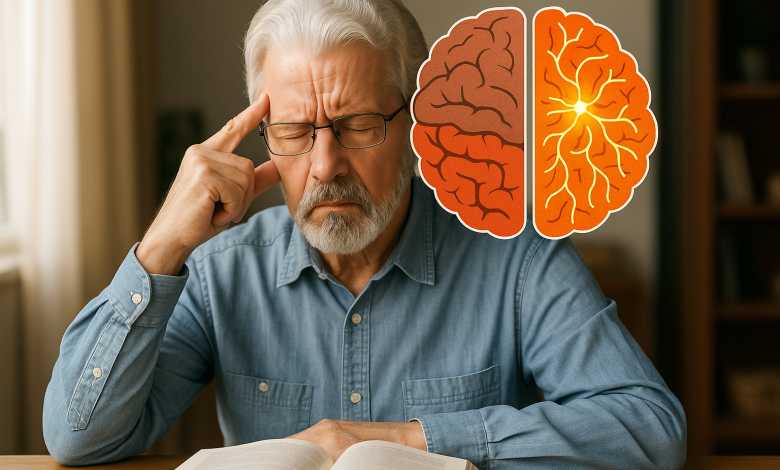Mental Exercise Can Reverse a Brain Change Linked to Aging, Study Finds

Have you ever felt that little pang when you can’t remember a name you once knew, or when your mind wanders in ways it didn’t use to? That subtle shift is part of what many of us dismiss as “just getting older.” But what if I told you that you have the power to reverse a brain change linked to aging — simply by using your mind in the right way?
Yes — emerging research suggests that mental exercise isn’t just helpful; it can literally turn back certain forms of brain aging. Here’s your guide to understanding what’s happening, how it works, and how you can harness it for your own brain’s benefit.
1. The Aging Brain: What’s Really Going On
As we age, our brains undergo subtle but measurable changes. One of these changes is a decline in levels of certain brain chemicals, or structural shifts in regions associated with memory, learning, and attention.
A compelling study titled “Mental exercise can reverse a brain change linked to aging, study finds” reports that targeted cognitive training boosted levels of a brain chemical that typically declines with age.
Another landmark trial found that an aerobic exercise intervention increased the volume of the anterior hippocampus (a memory-center region) by about 2%, essentially undoing one to two years of age-related volume loss.
These findings challenge the notion that brain aging is an unavoidable path — instead, they open the door to a more hopeful reality: you can intervene and make a difference.
2. Why Mental Exercise Matters: The Science Behind the Shift
2.1 Brain plasticity is alive and well
The human brain remains plastic — capable of changing, rewiring, and even growing in response to experience. The hippocampus study (above) showed significant increases in volume after exercise, so the brain was responding structurally.
Similarly, cognitive training research found that mental exercises can raise levels of important brain chemicals (for examplegrowth factors) and thus improve brain health.
2.2 Key brain regions targeted
- Hippocampus – central to memory formation and learning; tends to shrink with age, but can be stimulated to grow.
- Prefrontal cortex / executive networks – these regions govern attention, planning, and decision-making; studies show exercise helps these areas, too.
2.3 Dosage & frequency: What the research says
In one systematic review, older adults who engaged in more than 52 hours of physical exercise (spread over sessions, ~1 hour each) saw improved cognitive performance. While that speaks to physical exercise, the cognitive training research similarly emphasizes consistent, repeated engagement rather than occasional sessions.
Thus, one of the keys is regularity — show up for your brain the way you’d show up for your body.
3. What the Study Shows: Hope, Not Hype
The headline “mental exercise can reverse brain aging changes” is not just clickbait. The research behind it carries weight:
- The study on cognitive training reported that people who engaged in brain-stimulating tasks raised levels of a brain chemical that typically declines with age.
- The aerobic exercise hippocampus study showed that structural brain decline is not inevitable — the brain can grow instead of shrink.
- Reviews of many trials show consistent positive effects of exercise on global cognition, processing speed, and executive function.
In short, the evidence supports the claim that with the right stimuli, the brain is not doomed to decline. It can respond, recover, and rejuvenate.
4. How to Harness Mental Exercise: A Step-by-Step Plan
Here’s how you can turn the scientific findings into personal action. The following plan is structured, emotionally engaging, and designed to create momentum.
Step 1: Recognize Your Starting Point
Pause for a moment: what mental tasks feel harder than they used to? Is it remembering names, staying focused on a project, or shifting between tasks fluidly?
Labeling the challenge is the first step toward reclaiming your brain power. Emotionally, this is about becoming your own advocate — saying: I care about my mind, and I’ll invest in it.
Step 2: Choose Brain-Stimulating Activities
Your “mental exercise” menu could include:
- Learning a new language or musical instrument
- Playing strategy games or cognitive-training apps
- Engaging in complex tasks at work or hobbies (e.g., woodworking, coding, creative writing)
- Social engagement: conversation, teaching others, mentoring (true mental exercise)
Step 3: Make It Regular, Not Occasional
As with physical training, the brain matters more when you show up often:
- Aim for at least 30 minutes, 3-5 times per week, dedicated to focused cognitive challenge
- Mix up your tasks: don’t always do the same puzzle — challenge different domains (memory, reasoning, spatial, language)
- Stick to a schedule: morning brain-work? Evening session? Find your flow and protect it
Step 4: Combine With Body & Lifestyle Support
Brain health doesn’t operate in a vacuum. Combine mental exercise with:
- Physical activity (aerobic + strength) to support brain structure and circulation
- Healthy diet, hydration, sleep, and stress-management
- Social connection and new experiences (novelty stimulates the brain)
Step 5: Track Your Progress & Celebrate Wins
- Keep a journal: note when you started a new task, how you felt, and what you accomplished
- Observe changes: maybe you recall names quicker, stay focused longer, feel more mentally agile
- Celebrate: each improvement is a triumph — your brain is responding
Step 6: Embrace the Emotional Journey
Caring for your brain is an act of self-love and empowerment. The narrative is not “I’m losing something” but “I’m reclaiming, rebuilding, and renewing.”
Let that emotional resonance fuel your commitment.
5. Why This Matters for You (Yes, You)
Let me speak directly: if you’re reading this, you likely care about more than just staying busy. You care about staying sharp, present, alive. You want to engage with life fully — to love, to learn, to contribute.
By applying mental exercise as a deliberate strategy, you are making a choice: to invest in your most precious asset — your mind.
And here’s the truth: there is a huge emotional benefit in knowing that your brain is not a passive victim of time — it’s a partner.
Imagine this: five years from now, you’re still vibrant, mentally agile, full of new ideas. You’ve cultivated your mind like a garden. That vision is possible — and the tools are within your reach.
6. Overcoming Common Obstacles
Obstacle 1: “I’m too busy.”
Solution: Even short sessions (20-30 minutes) done consistently beat sporadic long ones. Use your commute, morning coffee time, lunch break.
Obstacle 2: “I’m too old / too far behind.”
Solution: Research shows brain plasticity at older ages; change is possible. The hippocampus study involved older adults and reversed brain decline. PMC
Obstacle 3: “I don’t know where to start.”
Solution: Pick something you’re curious about. New skill, new subject. Curiosity is a powerful driver for your brain.
Obstacle 4: “What if I fail?”
Solution: Remember: this is a process, not perfection. Celebrate small wins. Recognize progress, not just results.
7. Personal Story-Style Reflection
Let me share a fictional yet relatable moment that you might see yourself in:
On a morning walk, you realize you absent-mindedly wandered into the coffee shop, forgot your earphones, and spent the walk thinking about chores instead of listening mindfully.
You feel a twinge: Wait — wasn’t I sharper just a few years ago?
But then you remember: last week you began a short daily brain-challenge — 25 minutes of learning Spanish vocabulary after dinner, and every Saturday you joined a local chess club.
You notice this week: You remembered your friend’s new name; you solved a work problem faster than usual; you had a sharper image of the route home.
That little step, that daily act of training your brain, is not glamorous — but it’s profound. It tells your brain: You matter. Your mind is precious. We’re going to care for you.
That emotional connection — the recognition that you’re investing in yourself — is exactly what makes this more than just a “how-to” list. It becomes a journey worth walking.
8. Your 30-Day Kick-Start Challenge
Here’s a practical 30-day plan to kick off your brain-revitalization:
- Week 1 (Days 1–7): Choose your “brain exercise” activity. Commit 20-30 minutes daily. Set a reminder on your phone.
- Week 2 (Days 8–14): Add variety. On 3 days, do your main activity. On 2 days, ick a different challenge (like a logic puzzle, a new language phrase, or a creative drawing task).
- Week 3 (Days 15–21): Track your feelings. Note any small wins or changes. Celebrate them.
- Week 4 (Days 22–30): Reflect. What improved? How did you feel? Plan for the next 3 months: pick the same schedule, maybe extend time to 30-40 minutes, or add a social element (study with a friend, join a club).
By the end, you’ll have established a habit. The emotional anchor will be: I showed up for my brain. I cared for myself. And you will have given your mind a powerful boost.
9. In Conclusion: The Empowering Message
Here’s the truth I want you to carry away: your brain is not locked into decline because of age. With intention, with care, with repeated mental exercise, you can make meaningful changes — biochemical, structural, functional — that reflect in how you think, feel, remember, and engage with life.
You are not merely preserving what remains; you are building what’s next.
Let this be your choice: to not accept fading mental sharpness as “just how things are,” but to act, engage, grow.
The study telling us mental exercise can reverse age-linked brain changes is not only about science — it’s about hope. Hope for your future self, hope for the life you still want to lead, hope for the mind you still want to sharpen.
Start today. The first step is small — perhaps just 20 minutes of focused challenge. But your brain will thank you for it. And your future self will look back with gratitude.
Remember: you’re not aging out — you’re stepping up.




